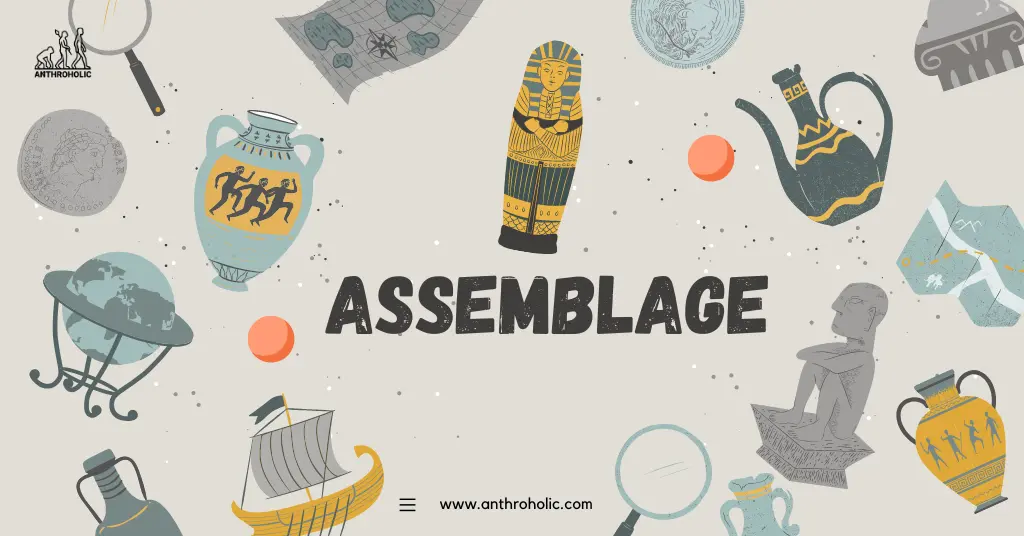AI Answer Evaluation Platform Live Now. Try Free Answer Evaluation Now
Assemblage
In archaeology, an assemblage refers to a group of artifacts that are related in some way, often found together in the same context, and therefore can be presumed to be associated with particular people, activities, or periods of time [1]. These artifact collections offer essential data for understanding cultural behavior throughout history, making them critical in the field of archaeology.

Conceptual Understanding of Assemblages
Definition and Application
The term ‘assemblage’ stems from French social theory, originally employed by philosophers like Gilles Deleuze and Félix Guattari [2]. Within archaeological discourse, it denotes an assortment of different artifacts found in a given archaeological stratum or strata, usually at a single archaeological site. Assemblages can comprise anything from pottery shards, tools, bones, to architectural remains [3].
Categorization of Assemblages
Archaeologists categorize assemblages into three main types:
- Type I: Assemblages found within the same stratigraphic layer, usually within the same site.
- Type II: Comprises assemblages from different stratigraphic layers but the same site, providing a chronological series.
- Type III: Contains assemblages from different sites but from similar stratigraphic layers, offering a regional perspective [4].
The Role of Assemblages in Archaeology
The concept of assemblages plays a vital role in archaeology, helping to:
- Understand the cultural, historical, and economic context of a site or civilization.
- Interpret social behaviors and rituals of past societies.
- Establish chronologies and conduct comparative studies across regions and periods.
Understanding Assemblages through Taphonomy
Taphonomy, or the study of the processes that contribute to the formation of archaeological records, helps researchers interpret assemblages. It provides insight into the ways objects were discarded, lost, or left behind, which can reveal important information about human behavior and cultural practices.
Case Study: Assemblage Analysis at the Moundville Site
One of the most compelling examples of assemblage analysis is the work done at the Moundville site in Alabama. In the Moundville case, archaeologists analyzed a broad range of artifacts from pottery to stone tools and human remains.
| Artifact Type | Number Found |
|---|---|
| Pottery Shards | 25,000 |
| Stone Tools | 10,000 |
| Human Remains | 1,200 |
The assemblages were classified and interpreted, revealing a rich understanding of the social hierarchy, religious practices, and economic activities of the Mississippian culture that lived there from AD 1000 to 1450.
Analytical Techniques and Assemblage
Stratigraphic Analysis
Stratigraphic analysis of assemblages involves the study of the relationship between different layers (strata) of a site. It helps to create a chronological sequence of events at a site by assessing the vertical position of assemblages in soil layers. As a rule of thumb, the deeper the layer, the older the assemblage.
Typological Analysis
Typology, the classification of artifacts based on physical characteristics, aids in understanding the evolutionary trend of human-made objects over time. Differences and similarities among artifact types within an assemblage can suggest changes in technology, function, and cultural preference.
Statistical Analysis
Statistical methods help identify patterns and associations within and between assemblages. Techniques such as seriation (ordering of artifacts based on style or frequency) and cluster analysis (grouping of artifacts based on shared characteristics) can offer crucial insights into cultural changes over time and space.
Conclusion
Assemblages play a crucial role in archaeological investigations, providing context, chronology, and cultural significance to unearthed artifacts. The multifaceted analysis of these assemblages, combined with understanding taphonomic processes, can reveal the past’s intricacies and mysteries.
References
[1] Schiffer, M. B. (1987). Formation processes of the archaeological record. Salt Lake City: University of Utah Press.
[2] Deleuze, G., & Guattari, F. (1987). A thousand plateaus: Capitalism and schizophrenia. Minneapolis: University of Minnesota Press.
[3] Renfrew, C., & Bahn, P. (2008). Archaeology: Theories, methods, and practice. London: Thames & Hudson.
[4] Dunnell, R. C. (1971). Systematics in Prehistory. Free Press, New York.




